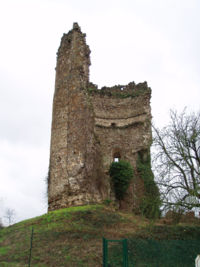
Donjon de Maurepas
Encyclopedia


Ruins
Ruins are the remains of human-made architecture: structures that were once complete, as time went by, have fallen into a state of partial or complete disrepair, due to lack of maintenance or deliberate acts of destruction...
medieval castle in the town of Maurepas
Maurepas, Yvelines
Maurepas is a commune in the Yvelines department in the Île-de-France region in north-central France. It is located in the western suburbs of Paris from the center.-demography:-History:...
, in the French département of Yvelines
Yvelines
Yvelines is a French department in the region of Île-de-France.-History:Yvelines was created from the western part of the defunct department of Seine-et-Oise on 1 January 1968 in accordance with a law passed on 10 January 1964 and a décret d'application from 26 February 1965.It gained the...
(Île de France
Île-de-France (région)
Île-de-France is the wealthiest and most populated of the twenty-two administrative regions of France, composed mostly of the Paris metropolitan area....
).
History
Since the 8th century, the village of Maurepas (formerly spelled Malrepast) belonged to the Abbey of Saint-DenisSaint Denis Basilica
The Cathedral Basilica of Saint Denis is a large medieval abbey church in the commune of Saint-Denis, now a northern suburb of Paris. The abbey church was created a cathedral in 1966 and is the seat of the Bishop of Saint-Denis, Pascal Michel Ghislain Delannoy...
. Facing the Normans
Normans
The Normans were the people who gave their name to Normandy, a region in northern France. They were descended from Norse Viking conquerors of the territory and the native population of Frankish and Gallo-Roman stock...
invasions, they left the domain to the Lords of Chevreuse
Chevreuse
Chevreuse is a commune in the Yvelines department in the Île-de-France region in north-central France.-History:Chevreuse was founded in the 10th century, and celebrated its first millennium of existence in 1980...
; the castle was given to the family of Malrepast. A wooden keep
Keep
A keep is a type of fortified tower built within castles during the Middle Ages by European nobility. Scholars have debated the scope of the word keep, but usually consider it to refer to large towers in castles that were fortified residences, used as a refuge of last resort should the rest of the...
was replaced by a stronger castle.
During the Hundred Years' War
Hundred Years' War
The Hundred Years' War was a series of separate wars waged from 1337 to 1453 by the House of Valois and the House of Plantagenet, also known as the House of Anjou, for the French throne, which had become vacant upon the extinction of the senior Capetian line of French kings...
, the Lords of Malrepast abandoned the castle; it was then used as a haunt by a band of plunderers. In 1425, the English captured and hung all the occupants of the castle.
The castle was then occupied by Aymon de Massy.
In 1432 the English conquered the area and dismantled the castle.
After the war, the domain of Maurepas returned to the family of Chevreuse
Chevreuse
Chevreuse is a commune in the Yvelines department in the Île-de-France region in north-central France.-History:Chevreuse was founded in the 10th century, and celebrated its first millennium of existence in 1980...
, but the castle remained a ruin.
Today, only the keep, which is 20m high (60 feet), remains on a low motte
Motte-and-bailey
A motte-and-bailey is a form of castle, with a wooden or stone keep situated on a raised earthwork called a motte, accompanied by an enclosed courtyard, or bailey, surrounded by a protective ditch and palisade...
. A farm leans on the ruins.
The keep has been listed by the French Ministry of Culture as a monument historique
Monument historique
A monument historique is a National Heritage Site of France. It also refers to a state procedure in France by which national heritage protection is extended to a building or a specific part of a building, a collection of buildings, or gardens, bridges, and other structures, because of their...
since 1926.

